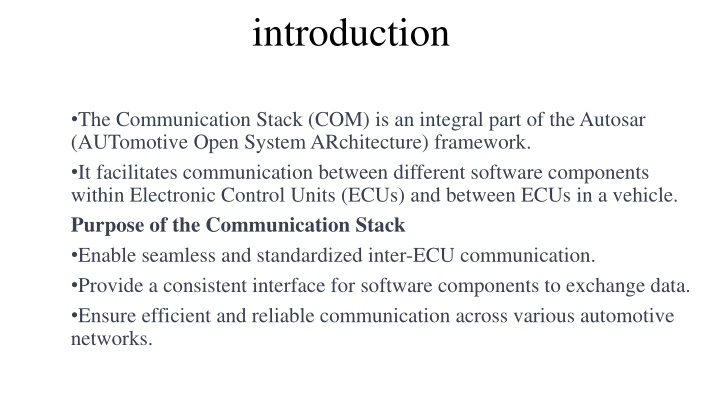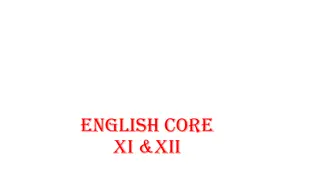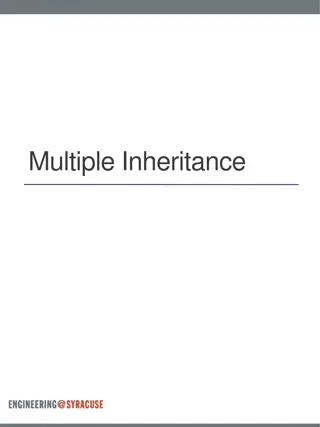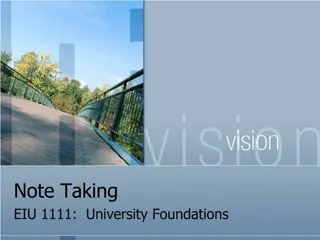
Autosar Communication Stack in Automotive Systems
The Autosar Communication Stack (COM) plays a vital role in facilitating standardized communication within Electronic Control Units (ECUs) in vehicles. It ensures seamless inter-ECU communication, reliable data exchange, and efficient networking across automotive systems. The stack consists of communication services, service interfaces, different layers for managing communication, and offers benefits like standardization and scalability. By enabling interoperability and enhancing overall system efficiency, the COM component contributes significantly to modern vehicle functionality and safety.
Download Presentation

Please find below an Image/Link to download the presentation.
The content on the website is provided AS IS for your information and personal use only. It may not be sold, licensed, or shared on other websites without obtaining consent from the author. If you encounter any issues during the download, it is possible that the publisher has removed the file from their server.
You are allowed to download the files provided on this website for personal or commercial use, subject to the condition that they are used lawfully. All files are the property of their respective owners.
The content on the website is provided AS IS for your information and personal use only. It may not be sold, licensed, or shared on other websites without obtaining consent from the author.
E N D
Presentation Transcript
introduction The Communication Stack (COM) is an integral part of the Autosar (AUTomotive Open System ARchitecture) framework. It facilitates communication between different software components within Electronic Control Units (ECUs) and between ECUs in a vehicle. Purpose of the Communication Stack Enable seamless and standardized inter-ECU communication. Provide a consistent interface for software components to exchange data. Ensure efficient and reliable communication across various automotive networks.
Communication Stack Components 1. Communication Services Responsible for managing communication services and protocol handling. Implement communication protocols such as CAN, LIN, FlexRay, Ethernet, etc. Ensure data transmission and reception between ECUs. 2. Service Interface Defines a set of standardized methods that software components use to access communication services. Provides an abstraction layer, enabling components to remain independent of the underlying communication protocols.
Communication Stack Architecture The Communication Stack is divided into several layers, each with specific responsibilities. Higher layers interact with application software, while lower layers interact with communication hardware.
Communication Stack Layers 1. Application Layer Topmost layer interacts with application software. Comprises software components and application interfaces. Requests for data transmission/reception are initiated from this layer. 2. RTE (Run-Time Environment) Layer Handles the exchange of information between the Application Layer and the Communication Layer. Encapsulates data and prepares it for communication. 3. Communication Layer Manages communication services and protocols. Ensures efficient data transfer between ECUs using the specified communication protocol (e.g., CAN, FlexRay). 4. Bus-specific Interface Layer Serves as an interface between the Communication Layer and the bus-specific drivers. Adapts the data to the specific requirements of the communication bus (e.g., CAN driver).
Communication Stack Benefits 1. Standardization Autosar-compliant Communication Stack ensures interoperability among various ECUs and communication hardware from different suppliers. 2. Scalability Adaptable to different vehicle architectures and communication requirements. Supports both small and large-scale automotive systems.
Conclusion The Communication Stack (COM) is a crucial component of Autosar, enabling standardized communication between ECUs in modern vehicles. It provides a robust and flexible solution for inter-ECU communication, contributing to the overall efficiency, safety, and reliability of automotive systems






















